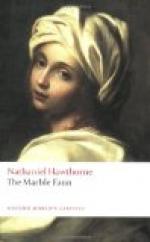MYTHS
After the sculptor’s arrival, however, the young Count sometimes came down from his forlorn elevation, and rambled with him among the neighboring woods and hills. He led his friend to many enchanting nooks, with which he himself had been familiar in his childhood. But of late, as he remarked to Kenyon, a sort of strangeness had overgrown them, like clusters of dark shrubbery, so that he hardly recognized the places which he had known and loved so well.
To the sculptor’s eye, nevertheless, they were still rich with beauty. They were picturesque in that sweetly impressive way where wildness, in a long lapse of years, has crept over scenes that have been once adorned with the careful art and toil of man; and when man could do no more for them, time and nature came, and wrought hand in hand to bring them to a soft and venerable perfection. There grew the fig-tree that had run wild and taken to wife the vine, which likewise had gone rampant out of all human control; so that the two wild things had tangled and knotted themselves into a wild marriage bond, and hung their various progeny—the luscious figs, the grapes, oozy with the Southern juice, and both endowed with a wild flavor that added the final charm—on the same bough together.
In Kenyon’s opinion, never was any other nook so lovely as a certain little dell which he and Donatello visited. It was hollowed in among the hills, and open to a glimpse of the broad, fertile valley. A fountain had its birth here, and fell into a marble basin, which was all covered with moss and shaggy with water-weeds. Over the gush of the small stream, with an urn in her arms, stood a marble nymph, whose nakedness the moss had kindly clothed as with a garment; and the long trails and tresses of the maidenhair had done what they could in the poor thing’s behalf, by hanging themselves about her waist, In former days—it might be a remote antiquity—this lady of the fountain had first received the infant tide into her urn and poured it thence into the marble basin. But now the sculptured urn had a great crack from top to bottom; and the discontented nymph was compelled to see the basin fill itself through a channel which she could not control, although with water long ago consecrated to her.
For this reason, or some other, she looked terribly forlorn; and you might have fancied that the whole fountain was but the overflow of her lonely tears.
“This was a place that I used greatly to delight in,” remarked Donatello, sighing. “As a child, and as a boy, I have been very happy here.”
“And, as a man, I should ask no fitter place to be happy in,” answered Kenyon. “But you, my friend, are of such a social nature, that I should hardly have thought these lonely haunts would take your fancy. It is a place for a poet to dream in, and people it with the beings of his imagination.”
“I am no poet, that I know of,” said Donatello, “but yet, as I tell you, I have been very happy here, in the company of this fountain and this nymph. It is said that a Faun, my oldest forefather, brought home hither to this very spot a human maiden, whom he loved and wedded. This spring of delicious water was their household well.”




